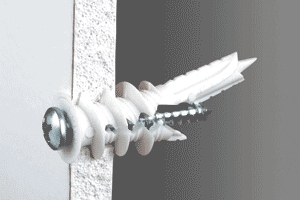There are many times you need to hang a picture or decorative piece on a wall, but can’t necessarily locate a stud. Instead of banging your head against the wall (this never works, only makes big holes), we’ll usually reach for self-drilling plastic drywall anchors. They hold a lot of weight, and they install easier than just about any other type of anchor.
The Many Names of Self-drilling Plastic Drywall Anchors
Self-drilling plastic drywall anchors go by a variety of brand names. You’ve got E-Z Ancor, Toggler, Hillman—even Hilti makes these. These drywall anchors are extremely versatile and come in many different configurations—from light duty to heavy duty. This makes them applicable for almost any use. They typically support anywhere from 30 to 85 pounds per fastener. These self-drilling screw-in plastic drywall anchors are made from nylon. If you use them correctly, they work really well.
Installation
Using a screwdriver—we do not recommend the use of a drill—you can screw these fasteners into drywall without pre-drilling. Watch out, though. If you have a heavily-painted wall, you want to “break” the surface first before screwing in the plastic anchor. Skip this step, and you might break off the tip.
We recommend taking your Phillips screwdriver and simply gouging a small starter divot right where you want to screw in the anchor. This starts the tip of the plastic self-drilling drywall anchor in the drywall instead of allowing it to skip across the painted surface.
Once the face of the drywall anchor is flush with the surface of the wall, add the included machine-threaded screw into the fastener. This parts the flanges, securing it within the wall so it can’t easily pull out. We’ve used plenty of the light- and medium-duty fasteners to secure pictures and even to hold up heavier items like loudspeakers and small shelves. In addition, they can be backed out by hand using a simple Philips head screwdriver.
Self-Drilling Plastic Drywall Anchors
The use of a self-drilling plastic drywall anchor can replace typical plastic plugs, which are not nearly as reliable and require pre-drilling. They also surpass the use of toggle bolts for low weight applications. Those leave a large hole and also require pre-drilling. The deep thread design provides a sufficiently strong attachment to gypsum/drywall of nearly any size, including 3/8″, 1/2″ and 5/8″. They will even work in most double drywall situations. Since the anchors are available in corrosion-resistant zinc and non-conductive white nylon, they can be used in almost any application.
Plastic drywall anchors are typically sold in packs of 10, 25, or 50. If you’ve never used these products, you owe it to yourself to check them out. They will save time and energy and are worth every penny.


